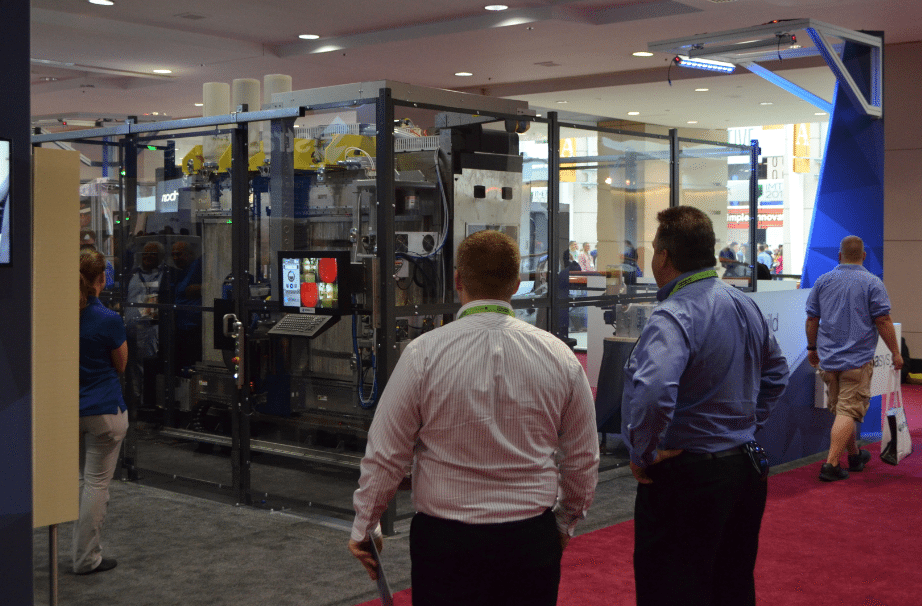Stratasys recently announced two new demonstrator models the Robotic Composite and Infinite Build. These proof of concept machines can be seen as a strong statement that the company are serious about moving 3D printing to the industrial production stage.
3DPI reported the news as it broke, and this week at Chicago’s IMTS I caught up with several of the team behind the technology.
Mike Boswell is the Lead Systems Engineer for the team who built the Infinite Build machine. And Dick Anderson is a senior VP of Research and Development. Anderson leads the FDM R&D team at Stratasys.
Next to the towering Infinite Build Machine they talk me through the demonstrator model. Anderson says, “FDM is a technology we’ve got here in our Fortus line and all of our other printers.”

A new 3D printing extruder
Anderson describes Infinite Build as a “technology demonstrator.”
“This is an Infinite Build 3D printer technology demonstrator. What we’ve done is we’ve turned 3D printing on its head here and we’ve put many new things in.” One of those things is building in a different orientation. “That allows us to be infinite length,” explains Anderson. “This is something the manufacturing industry has been crying out for.”
“They need longer, larger parts,” says the R&D leader. “This allows them to do that. Also Mike’s team has created a new extruder called a Screw extruder.”
“Again we’ve recognized that our traditional extruders haven’t been fast enough or have enough control to them so the screw extruder now can print a part at 10x what we could do with our traditional extruder.”
Strategic Partnerships with Ford & Boeing
Anderson points to a mold approximately 4 feet long. “That is a molding tool we just printed,” he says. “We’ve partnering with customers who are helping us drive manufacturing application spaces.” These partners include aerospace giant Boeing and also the Ford Motor Company. Anderson says these are, “two prime industries for us and as we become stronger in manufacturing, we recognize we need their help.”
Indeed, in an announcement made earlier in the week, also at IMTS, by 3D Systems the company acknowledged the advantages conferred via engagement with strategic partners.
“So with Boeing and Ford and the ability to print longer, larger parts much faster and a lot better uptime reliability.” This is because, “Mike’s team has integrated a pressure sensor into the end of the extruder tip.” With this addition the Infinite Build machine can, “sense the pressure change and before we have a problem with the build itself we can use a tool changer. This is also new to this system and new to us, and we can go to this tool changer and automatically bring in a new extruder.”
Automation and in process monitoring are both fundamental elements of Industry 4.0, or the Smart Factory concept, with this approach it would seem that Stratasys are providing functionality that may allow an eventual commercial model to be utilized in such a modern manufacturing environment.
“10 times as fast”
I ask Mike Boswell to explain more about the new screw extruder.
“It’s a micro screw extruder. We extrude about 20,000 micro-cubic inches a second of material. This is about 10 ten times what our current technology does.” He continues, “It feeds a micro-pellet feedstock.” This feedstock is carried in a 3 lb. hopper and the machine, “consumes about 1 lb of that material per hour while we’re building.”
Located in an area above the print head and hopper are additional stocks that are available to replenish the hopper when required. Boswell explains that the hopper is filled, “from a larger 30 lb general container up top.”

One of the early prints, before 3D models were received, was part of a canoe. “We were looking to build large parts and one of the large parts we were working up before we had actual industry parts to work with was part of a canoe.”
The largest component printed so far is, “a piece of duct work 16 feet long,” says Boswell. Anderson adds, “and its complicated duct work, there’s complex geometry and a spiral.” This is, “shape-changing duct work, not just a box.”
To manufacture such a piece would be beyond traditional methods. “The intent was to pick a piece that couldn’t be made by traditional manufacturing technology,” says Boswell.
“Ducting has been one of the applications that customers have been crying out for a different way to do” says Anderson. This is because, “it’s way to expensive the way they do it today”.
He concludes that the Infinite Build is an approach that, “can really answer some needs.” As more announcements around the industrialization of 3D printing appear, it will be interesting to see how Stratasys approach the commercialization of the Infinite Build and the Robotic Composite technology. The partnership with Boeing and Ford is yet another example of the steady progress AM is making within industry, 3DPI will have a special report on this topic soon.
Visitors to IMTS can see the Infinite Build technology demonstrator in action at the Stratasys booth located at N-60 in the North Hall.
Featured Image: Anderson (far left) and Boswell watch the Stratasys Infinite Build in action at IMTS (photo by Michael Petch)



